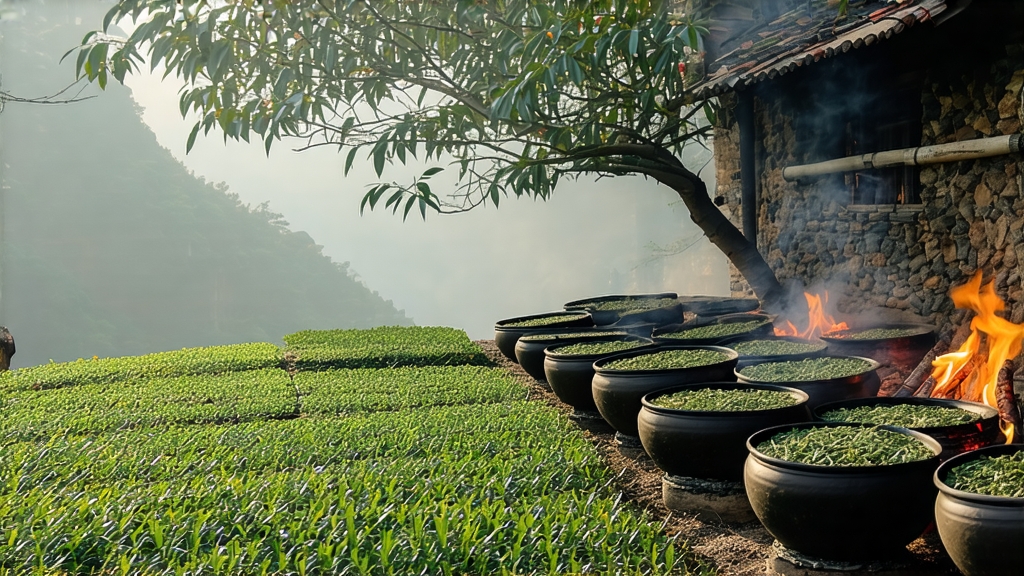
Long before English tea clippers raced across the oceans and Victorian parlors rang with the clink of bone-china cups, a small village deep in China’s Wuyi Mountains was already perfuming its tea with pine smoke. That village—Tongmu Guan, barely a scattering of stone houses tucked into a ravine of Fujian Province—gave the world its first fully oxidized leaf and, in doing so, defined what “black tea” would mean for centuries to come. The tea is Lapsang Souchong, and every later variety—Keemun, Yunnan Gold, Assam, Ceylon—owes its existence to the techniques first perfected on these fog-soaked slopes in the mid-seventeenth century.
Origin and legend
Local lore claims the smoke-drying method was born of military urgency. Qing soldiers, the story goes, commandeered a tea factory during the tumultuous transition from Ming loyalists to Manchu rule. Fearing the leaves would spoil, workers hastily dried them over fresh pine embers so they could flee. The accidental infusion of resinous aroma proved so captivating to Dutch traders at the port of Xiamen that they paid double the usual price and named the tea “Bohea,” a corruption of “Wuyi.” Whether myth or marketing, the tale underscores a truth: Lapsang Souchong was the first Chinese tea purpose-built for export, its assertive fragrance engineered to survive months in damp ship holds and still arrive in Amsterdam or London with personality intact.
Terroir: why only Tongmu Guan can be authentic
UNESCO lists the Wuyi range as a World Heritage Biosphere Reserve for its subtropical forest, mineral-rich clays, and diurnal temperature swings that can exceed 15 °C in a single spring day. Within this 60-km band of sheer cliffs and winding ravines, the 48 km² Tongmu Guan micro-basin is further shielded by evergreen pine and cedar. The cool night air slows oxidation, while the resinous forest litter perfumes the soil. Chinese law now restricts the use of “Zheng Shan” (literally “Original Mountain”) to leaves picked inside this core zone; anything else must be labeled “wai shan” and is considered imitation. Authentic Lapsang Souchong is therefore a geographic singularity, as narrowly defined as Champagne in France or Darjeeling in India.
Two styles: traditional pine-smoke vs. unsmoked “new craft”
International consumers usually picture a tar-black, intensely smoky leaf, yet within China connoisseurs increasingly favor an unsmoked version called “wild lapsang” that showcases the tea’s natural longan-fruit sweetness. Both styles begin identically: one bud and the first two leaves are plucked in late April when the catechins are balanced between floral and malty. The difference appears at the final drying stage.
Traditional pine-smoke process
- Withering: 8–10 h on bamboo racks above gently smoldering pine embers (Pinus massoniana) kept below 40 °C so the leaf dehydrates without cooking.
- Rolling: 45 min of machine-assisted bruising to rupture cell walls and initiate oxidation.
- Oxidation: 3–4 h in cedar-lined wooden troughs; the pile is turned every 30 min to ensure even exposure to oxygen, darkening the leaf to a coppery mahogany.
- Pan-firing: a quick 220 °C toss for 90 s to arrest oxidation at 85 %, fixing the color and priming the leaf for aroma absorption.
- Smoking & drying: the crucial step. Fresh pine logs are split, partially dried, then lit so they burn with a resinous flame. The leaf is spread on sieves 1.5 m above the fire for 6–8 h, absorbing volatile phenols (guaiacol, syringol) that create the signature campfire note. Masters judge readiness by aroma alone; when the smoke shifts from sharp to sweet, like caramelized pine sap, the tea is finished.
Unsmoked “new craft”
Developed in 2005 for the domestic market, this version skips the final smoke. Instead, the leaf is baked at 80 °C over charcoal made from local hardwoods, then rested for 30 days so the native honey and longan notes mellow. The result is a burgundy-colored liquor